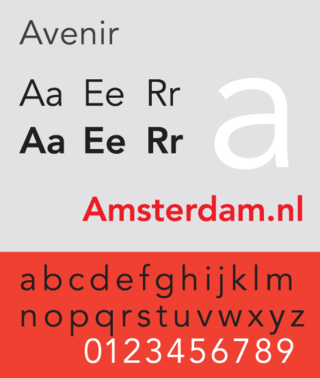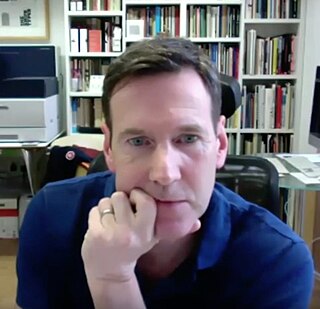
Palatino is an old-style serif typeface designed by Hermann Zapf, initially released in 1949 by the Stempel foundry and later by other companies, most notably the Mergenthaler Linotype Company.

Helvetica, also known by its original name Neue Haas Grotesk, is a widely used sans-serif typeface developed in 1957 by Swiss typeface designer Max Miedinger and Eduard Hoffmann.

Frutiger is a series of typefaces named after its Swiss designer, Adrian Frutiger. Frutiger is a humanist sans-serif typeface, intended to be clear and highly legible at a distance or at small text sizes. A popular design worldwide, type designer Steve Matteson described its structure as "the best choice for legibility in pretty much any situation" at small text sizes, while Erik Spiekermann named it as "the best general typeface ever".

Adrian Johann Frutiger was a Swiss typeface designer who influenced the direction of type design in the second half of the 20th century. His career spanned the hot metal, phototypesetting and digital typesetting eras. Until his death, he lived in Bremgarten bei Bern.

Comic Sans MS is a sans-serif typeface designed by Vincent Connare and released in 1994 by Microsoft Corporation. It is a non-connecting script inspired by comic book lettering, intended for use in cartoon speech bubbles, as well as in other casual environments, such as informal documents and children's materials.

Apple Inc. uses a large variety of typefaces in its marketing, operating systems, and industrial design with each product cycle. These change throughout the years with Apple's change of style in their products. This is evident in the design and marketing of the company. The current logo is a white apple with a bite out of it, which was first utilized in 2013.

Webdings is a TrueType dingbat typeface developed in 1997. It was initially distributed with Internet Explorer 4.0, then as part of Core fonts for the Web, and is included in all versions of Microsoft Windows since Windows 98. All of the pictographic Webding glyphs that were not unifiable with existing Unicode characters were added to the Unicode Standard when version 7.0 was released in June 2014.

Georgia is a serif typeface designed in 1993 by Matthew Carter and hinted by Thomas Rickner for Microsoft. It was intended as a serif typeface that would appear elegant but legible when printed small or on low-resolution screens. The typeface is inspired by Scotch Roman designs of the 19th century and was based on designs for a print typeface on which Carter was working when contacted by Microsoft; this would be released under the name Miller the following year. The typeface's name referred to a tabloid headline, "Alien heads found in Georgia."

Vincent Connare is an American type designer and former Microsoft employee. Among his creations are the fonts Comic Sans and Trebuchet MS, as well as the Man in Business Suit Levitating emoji. Besides text typefaces, he finalized and hinted the font Marlett which has been used for scalable User Interface icons in Microsoft Windows since 1995 and created portions of the font Webdings that was first shipped with Internet Explorer.

Trebuchet MS is a humanist sans-serif typeface that Vincent Connare designed for Microsoft Corporation in 1996. Trebuchet MS was the font used for the window titles in the Windows XP default theme, succeeding MS Sans Serif and Tahoma. Released free of charge by Microsoft as part of their core fonts for the Web package, it remained one of the most popular body text fonts on webpages as of 2009.

Curlz MT is an OTF display typeface designed by Carl Crossgrove and Steve Matteson in 1995 for Agfa Monotype. It is distinct from other popular typefaces, characterized by its wavy strokes and swirls at the beginning or end of letters. Similar to Comic Sans and Papyrus, the font has garnered criticism from graphic designers for being used excessively in inappropriate ways. Curlz was designed as a casual, decorative typeface.

DIN 1451 is a sans-serif typeface that is widely used for traffic, administrative and technical applications.

Gotham is a geometric sans-serif typeface family designed by American type designer Tobias Frere-Jones with Jesse Ragan and released through the Hoefler & Frere-Jones foundry from 2002. Gotham's letterforms were inspired by examples of architectural signs of the mid-twentieth century. Gotham has a relatively broad design with a reasonably high x-height and wide apertures.

Avenir is a geometric sans-serif typeface designed by Adrian Frutiger in 1987 and released in 1988 by Linotype GmbH.

Ubuntu is an OpenType-based font family, designed to be a modern, humanist-style typeface by London-based type foundry Dalton Maag, with funding by Canonical Ltd. The font was under development for nearly nine months, with only a limited initial release through a beta program, until September 2010. It was then that it became the new default font of the Ubuntu operating system in Ubuntu 10.10. Its designers include Vincent Connare, creator of the Comic Sans and Trebuchet MS fonts.

Nokia Pure is a typeface designed by London-based type foundry Dalton Maag for Nokia. It was designed primarily for use in digital media, in Nokia devices, and mobile environments. It has been the company's main typeface since its introduction. Its designers include Vincent Connare, creator of the classic font Comic Sans.

Dalton Maag is an independent font foundry with offices in London, UK, and São Paulo, Brazil. It designs fonts for use in corporate identities, logos, and other text uses. Dalton Maag has a library of 30 retail fonts as of 2016 and offers custom font creation and modification services to its clients.

Jeremy Tankard is a British type designer. Tankard has designed retail fonts independently and for FontShop and Adobe. Corbel was designed for Microsoft and has been included in Microsoft Office and Windows since 2006.




















